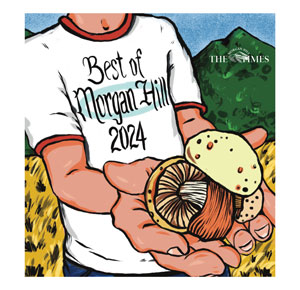
The sun was low in the winter sky, making it difficult to get a clear shot of the front of the ancient ivy-covered rockwall face of the oldest winery in Santa Clara Valley. I could barely make out the words “E. Guglielmo & Son, Bonded Winery No. 3656,” in black lettering against a white background above the ancient doors to the edifice.
Those words have graced that edifice for 100 years.
Brothers Gene and George Guglielmo, along with their children and grandchildren, were surrounded Jan. 11 by their extended and loyal family of customers going back decades as they commemorated the 100th anniversary of the establishment of the winery that is now in its fourth generation of family ownership.
They were joined by Morgan Hill Mayor Mark Turner, Morgan Hill Chamber of Commerce President Nick Gaich and Monsignor Gene O’Donnell, who gave the blessing.
Gene welcomed the gathered crowd to celebrate the 100-year milestone of continually operating a family-owned business, a rarity these days. He reflected that the family had grown over the years to include all the many friends and customers, and people with whom they developed special relationships.
“We try to continue that philosophy of friendship to this day,” he said. “We have a lot to celebrate, and we pay homage to all the staff and workers who have been part of our success.”
Pointing to the old house that now contains the winery offices, he noted that it had been a privilege to live in that house, growing up in a fantastic area that produces world class wine.
He noted, with some irony, that the wine industry is facing some serious headwinds, as wine consumption has been steadily declining for the last two years.
“People aren’t drinking wine like they used to,” he remarked. “When my grandparents started the winery, their customers were Italian, Basque and Irish. They considered wine part of a meal.”
The Guglielmo wines in the early days were delivered to customers in bulk, much as the milkman used to deliver milk. You had a choice of Sauternes (white) and the Red Burgundy.
George and Gene’s grandfather, Emilio, initially acquired about 10 acres on the homestead off Main Avenue, adding more acreage over time, some of which has been sold off as Morgan Hill continues to grow. There was also a chicken coop where Guglielmo Winery’s event center now stands.
“We used to own 40 acres where the Target is now,” Gene said. “We now have about 85 acres left.”
They continue to grow petite sirah, zinfandel and merlot, and recently planted estate cabernet sauvignon and sagrantino, a grape that harkens back to their family roots.
George reflected on the fact that Emilio emigrated from a small town north of Turin in Piemonte, Italy, in 1909, going through Ellis Island and making his way to San Francisco, where there was a vibrant Italian community.

Emilio spoke both French and Italian, and in fact, George says that his 23 and Me profile shows he is more French than Italian. Emilio then sent for his sweetheart Emilia, and they lived in San Francisco where he worked in a tannery, among other businesses, eventually amassing enough money to purchase the first 10 acres of land in Morgan Hill. They built a home, planted vines and began making wine in the basement.
Ah, the basement. Like many root cellars, it is accessed by a trap door that takes you underground. This secret cellar happens to be underneath the former residence that now serves as the Guglielmo Winery main office.
Gene explained that his grandfather built this place to raise his family, and for a time, the second generation, George and Maddeline, lived with them. The third generation, George, Gene and Gary (now deceased), all lived here as well, until their parents purchased another large ranch nearby. Then they moved to the house where Gene and his wife, Laura, live today.
Gene and George clearly delight in showing off the old redwood tanks, which were made in San Francisco, then disassembled so they could be moved into the cellar where they were then put together. They are still used to age wine, and they are massive, but not nearly as massive as the ones that tower above you as you walk into the winery production facility.
These are absolute monsters, dominating the enormous cellar from floor to ceiling. Most modern wineries have only steel tanks these days for fermentation. Very few have these giant wooden vessels which speak of old world ways and new world ambition.
Today, the winery still makes wine the same way it always has, picking early to preserve brightness and to keep alcohols low. This is the way wine was made to be consumed with a meal, to enhance the flavors of the table, and to gladden the hearts of grateful farmers and laborers, who cherished their daily glass of wine along with their daily bread.








We have know them, grown up with them and celebrated many occasions at their Winery over the last 60+ years. They are a cornerstone in our community and represent a very strong position of heritage and history in Morgan Hill.